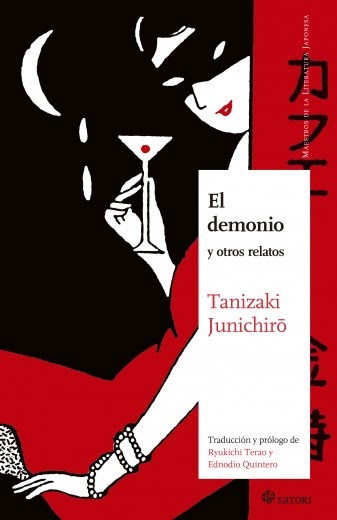
Original language: Japanese
Translation: Ryukichi Tearo / Ednodio Quintero
Year of publication: 1912-1925
Valuation: Recommended (with nuances)
What interesting stories, these compiled in The devil and other stories. Originally published between 1912 and 1925, they belong to the pen of a young Junichirō Tanizaki. The author’s novice is mainly reflected, as the introductory note of this volume highlights, in his “infatuation (…) for Western forms and customs” (pg. 17). Also in its narrative vigor and intensity, which sometimes act to the detriment of organic plot development or thematic exposition.
For the rest, the stories are extremely reminiscent of the author’s work, regardless of what age he wrote it. Especially for his accurate psychological portraits, his predilection for the dark side of the human being, his display of decadent eroticism and his stylistic finesse.
Let me stop for a moment on the characters conceived by Tanizaki, because they are truly extraordinary. Hateful as well as endearing, another characteristic feature must be added to their complexity: their contradictory tendency. The majority are men, professional writers or students, and have artistic pretensions or certain intellectual gifts.
Many of them are aware that their attitudes are “criminal”, “immoral” or “crazy”. Still, they find ways to rationalize their evil, their selfishness, and their vices. Above all, they appeal to human nature, or rather, to their own predisposition as individuals. However, that does not prevent them from accusing society of its defects immediately afterwards.
Let us examine, for example, the protagonist of “Heretic Sadness”, who first states this: «Before regretting what he had done, Shozaburo preferred to hate himself for that incorrigible defect that he considered innate to his person. / Repentance should be accompanied by penance. But Shozaburo’s self-criticism did not lead him to think about the need to change his way of being. He knew perfectly well that he would not be able to do it, even if he wanted to.” (pg. 355) Later, this same character radically changes his position and accuses his “meanness” of “the economic hardships that he had been forced to suffer.” (pg. 347)
It is true that some stories of The devil and other stories would benefit from further development. For example, those focused on the psychological portrait of the protagonist (“The Criminal”, “A Confession” and “The Hate”) often deliver a unique narrative voice and characterization; However, they give the impression that they could insert these into a larger plot, as happens in “Jotaro, the masochist”, “Heretic sadness” or “The demon”.
These last three pieces, by the way, are among my favorites. Maybe they are not perfect, since their finish and execution is not as round as I would like. “Jotaro, the masochist” wastes some secondary character, and does not make the most of the protagonist; On the other hand, “Sadness of Heretic” has very powerful parts, but they do not quite fit into the whole; As for “The Demon”, it barely outlines its hard core. In any case, the three stories shine with the vigor of their prose, the audacity of their premises, their memorable protagonists and their literary authenticity.
Another very good story, I would almost dare to say perfect, is “The Little Kingdom.” In addition to starting from an interesting and original premise, it is perfectly plotted.
At this point, I can only briefly summarize the texts that make up The devil and other stories:
- “The creation”: An artist wants to pair two beautiful young people so that they give birth to a perfect son. Both the plot and the characters are quite flat, so its only attraction is, in my opinion, that it is narrated solely with dialogues (with the exception of a few chronological notes).
- “The criminal”: Monologue of a painter who has ended up in jail after swindling an acquaintance. The reflections on the psychology of the criminal that emerges are extremely curious.
- “A confession”: Interrogation that tries to clarify the motivations for beating, robbing and murdering a man. Written exclusively based on dialogue, it presents dark humor and a rather twisted internal logic.
- “Hate”: Intense and forceful description of hatred in its purest form, with all its cruelty and irrationality.
- “A handful of hair”: Three mixed-race friends compete among themselves to marry an attractive Russian woman. Nice and entertaining mischief set in the Tokyo-Yokohama earthquake of 1923.
- “A blue flower”: A forty-year-old walks with his teenage lover. Perhaps the most ambitious structurally speaking, as it mixes reality and dream, present and past with equal ease. In addition, it provides very powerful contrasts between the Japanese and the Western.
- “Story of a woman turned into a monkey”: An unfortunate geisha becomes the object of desire of a primate who will not leave her alone until he manages to possess her.
- “Jotaro, the masochist”: A relatively successful writer embarks on a sordid adventure to satisfy his lust.
- “Sadness of a heretic”: The first-born of an impoverished and dysfunctional family It has very powerful scenes, like that one with the gramophone
- “The Demon”: A student from the provinces goes to live with his aunt in the city to study law and will find himself integrated into a love triangle full of jealousy and perversion with his ambiguous cousin and the jealous gardener.
- “The Little Kingdom”: A teacher tries to combat a new student who has taken over all his classmates with astonishing ease.
Summarizing: The devil and other stories It is, despite its irregularity, a recommendable anthology. His stories maintain a certain thematic and tonal unity, but they still display very varied extensions and techniques. Without a doubt, this almost embryonic phase of Tanizaki, the eternal candidate for the Nobel Prize in Literature, deserves to be known.
Source: https://unlibroaldia.blogspot.com/2024/04/junichiro-tanizaki-el-demonio-y-otros.html


